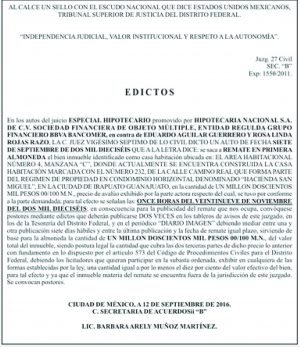Edictos y licitaciones
How to publish Edicts?
We offer advice and digital certification of your publication.

¿Donde publicar edictos?
Publicar edictos en El Universal Diario de Mexico Diario Imagen Sol de Mexico Excelsior La Jornada y todos los periódicos cdmx y todos los estados de Mexico.
What is an Edict?
Edict is defined in modern law as a mandate, ordinance or decree published by the authority of the prince, magistrate, judge or administrative authority in order to promulgate a provision, give notice of the celebration of an act, make a resolution public or to officially calls someone.
The etymological meaning of the word Edict comes from the Latin <> which at the same time comes from the verb <> which means to prevent, warn or proclaim aloud. This word also contains <> which means “to tell”.
This legal tool was created for the first time in Roman Law around the 4th century BC. as a procedural communication used by the cities praetors (praetores urbanus) as part of the litigation of the Roman citizens. Later, this faculty would be extended to the praetor peregrinus who could proclaimed about situations in which foreigners also could intervened.praetores urbanus) en lo que correspondía a los litigios llevados entre los ciudadanos romanos. Más tarde dicha facultad se extendería al praetor peregrinus quien podría hacer proclamas respecto a los asuntos en los que también intervinieran extranjeros. Dicha acción de generar anuncios públicos se conocía como ius edicendi, y concedía a los pretores la potestad de publicar un edicto anual en donde se establecían las normas antiguas y nuevas que regirían su actuar durante su mandato de aproximadamente un año (lex annua). En caso de un imprevisto el pretor tenía la facultad de generar un edicto específico para dicho caso (Edictum repentinum).
En adelante, el edicto se convirtió en una fórmula imperial que solo el soberano emitía y reformaba, sobre algún asunto concerniente a la justicia o administración de su imperio como parte de las constituciones imperiales. Es el tiempo de importantes edictos imperiales que trascendieron a la historia como el Milán de Constantino que otorgó la libertad de religión en el imperio romano y el de Tesalónica promulgado por Teodosio que volvería al cristianismo su religión oficial. Uno de los últimos edictos considerados dentro del derecho romano pero ya con la clara impronta bávara es el Teodorico que data del año 503.
This action of generating public announcements was known as ius edicendi, and it granted the praetors the power to publish an annual edict which established the old and new norms that would govern their actions during their mandate of approximately one year (lex annua). In the event of an unforeseen event, the praetor had the power to generate a specific edict for this case (Edictum repentinum).
México, la Secretaría de Medio Ambiente y Recursos Naturales “SEMARNAT” es la entidad responsable de la recepción, evaluación y resolución de dictámenes de impacto ambiental a personas físicas o jurídicas que deseen realizar algún proyecto que incluya una obra o actividad señalada en el artículo 28 de la LGEEPA y 5to del RLGEEPAMEIA pero que no involucren sustancias o actividades The Mexican Legal Dictionary of the Institute of Legal Research (1994) written by Ignacio Medina Lima defines an Edict as “Public notification made by an administrative or jurisdictional body, of an agreement or resolution that must be known for its fulfillment or for legal effects in relationship with those interested in the matter they concern. " And "this class of communication acts, which may include locations, notifications, citations, requirements, etc., is carried out in the cases specifically indicated by law when it is not possible to carry them out through personal notifications to the recipients and their effects are equated to them. " Additionally, it is mentioned: "At the time when the aforementioned procedural codes were elaborated in Mexico, it is not found."
Environmental impact
Environmental impact is defined as the "Modification of the environment caused by the action of humans or nature". The environmental impact can be Negative, Positive, direct, indirect, reversible, irreversible, continuous, periodic, cumulative and residual. In Mexico, the Ministry of the Environment and Natural Resources "SEMARNAT" is the entity responsible for receiving, evaluating and resolving environmental impact reports, from natural or legal persons who wish to develop a project, that includes a work or activity indicated in article 28 of the LGEEPA and 5th of the RLGEEPAMEIA, but that do not involve substances or activities considered highly risky according to what is indicated in the "First and Second Lists of highly risky activities", published in the DOF, on March 28, 1990 and 04 May 1992.


